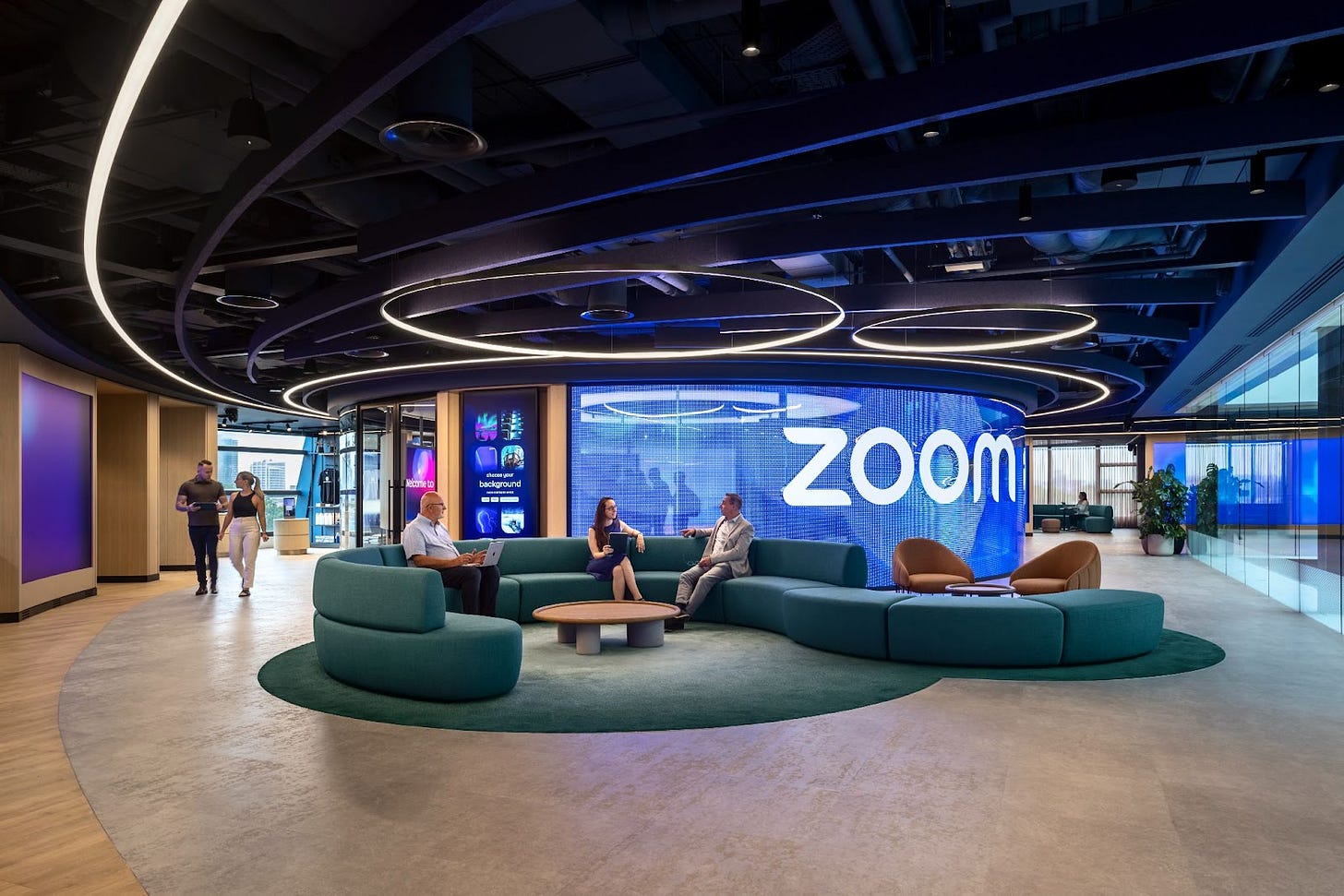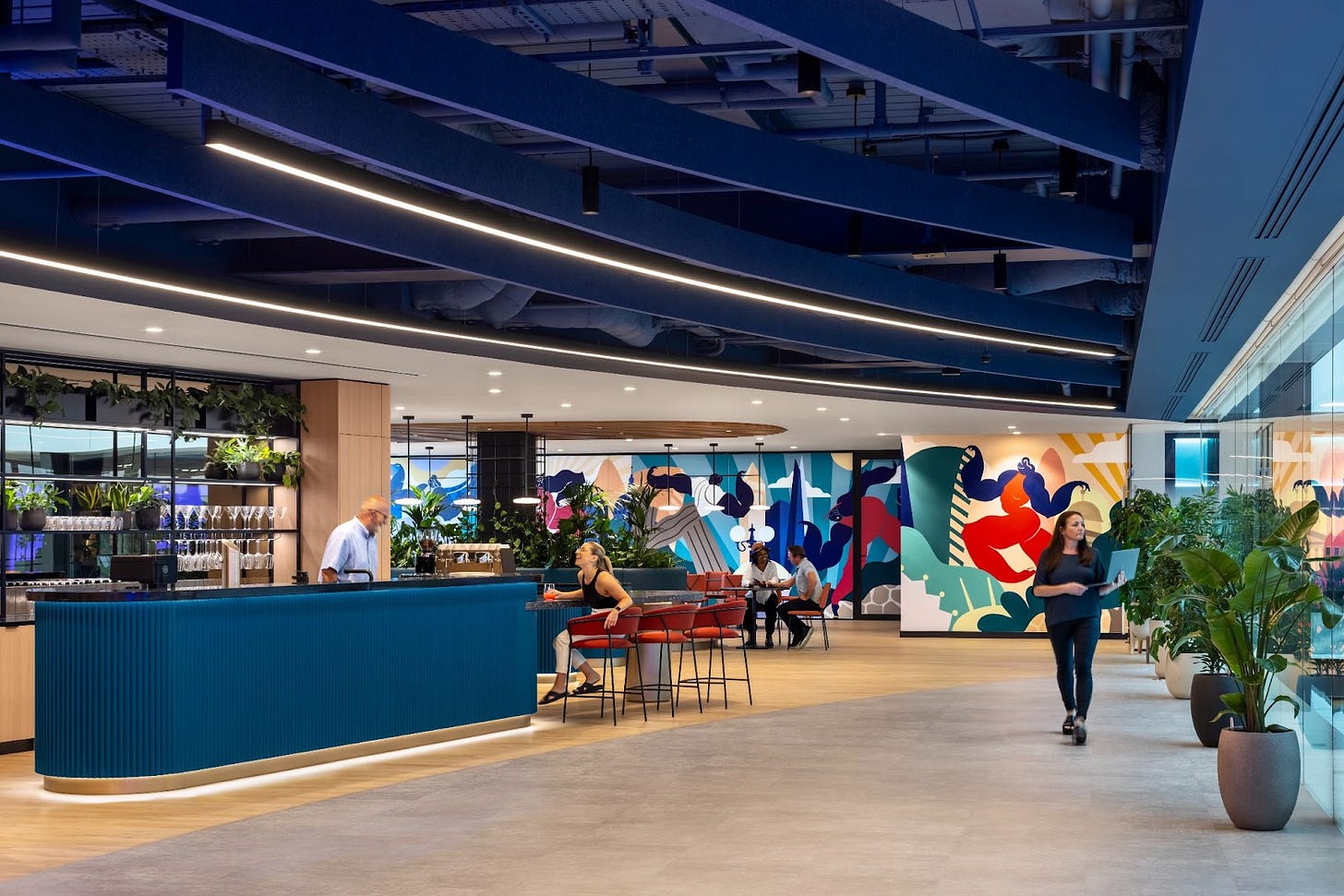Learning While Leading
How Zoom's Izabella Lorenz Transformed Workplace Strategy Through Customer-Centric Design
When you join a “small startup” three months before a global pandemic transforms it into a household name, you learn to embrace change—fast.
Izabella Lorenz didn’t expect her career pivot to Zoom to become a masterclass in workplace transformation. Heading Global Real Estate and Workplace Strategy, she’s overseen Zoom's evolution from traditional office rows to what they call “engagement hubs" – spaces that serve both employees and customers in ways that would have seemed impossible just five years ago.
Her journey offers a compelling case study for leaders grappling with their own workplace challenges: how do you design spaces that truly serve their purpose when everything about work has fundamentally changed?
Zoom’s London Experience Center
The Accidental Transformation Expert
Lorenz’s path to workplace leadership reads like a masterclass in adaptability. She started in business administration, pivoted to design consultancy, then built a successful relocation company from a single van she originally bought for a European holiday road trip. “Believe it or not, ten years later, this was a huge company,” she recalls. “We were working for Google, Nike, Adidas, all the big companies relocating their employees.”
That client relationship with Google opened doors to a facilities role there, where she spent six and a half years. But as the company grew, she felt her impact diminishing. “Everything is working there, but after a while you’re just ticking the boxes,” she explains. “I thought: I want something small. I want something startup.”
Izabella Lorenz, Global Real Estate and Workplace Experience Leader at Zoom
Enter Zoom, three months before the pandemic. “Everyone was telling me: What are you doing? Nobody knows this company,” she laughs. Then COVID hit, and her “small startup” became the backbone of global remote work practically overnight.
The lesson here isn’t just about timing, it’s about recognizing when you need to stretch beyond your comfort zone. “For me, what’s important is just the ability to learn every day,” Lorenz says. “If something is stagnant, I’m doing the same thing over and over for weeks. That’s it. I’m gone.”
Since growth has also driven my own career decisions, I got what Izabella meant. I also noticed that when she described how hard the challenges were, she had a big smile on her face. What challenges us at the time in retrospect often become our biggest accomplishments, and how we learn and grow.
From Headcount to Experience: Rethinking Office Strategy
Before the pandemic, Zoom’s approach to real estate was pretty standard — a set number of desks per employee, plus a few Zoom Rooms and shared spaces... Traditional thinking for a traditional approach to work.
The pandemic forced a fundamental rethink. “Within two years, we went from 2,000 employees very much co-located around key areas to 9,000 people totally distributed,” Lorenz explains. That’s not just growth: it’s a complete transformation of how work happens.
Instead of shrinking back to pre-pandemic norms, Zoom doubled down on flexibility. Today, they maintain no leases longer than two to three years, own zero real estate, and mix leases with flex providers. “We want to be flexible,” Lorenz says simply. But flexibility without purpose is just chaos.
The key shift? Moving from measuring “butts in seats” to focusing on outcomes. “It used to be, how many people do you put in the seats,” she explains. “Now it’s the why: what are they able to do once they are here? That’s the important thing, and I think this shifted how we design and how we operate the space.”
The Customer-Employee Integration Revolution
Here’s where Zoom's approach gets particularly interesting: they’ve fundamentally reimagined the role customers play in workplace design. Their flagship Experience Center in London hosts 500 customers monthly while serving as a working space for employees.
The space features what Lorenz calls a “lens wall” – a 38-meter ambient fabric installation covering the entire floor. With one touch of the button, you can transform the entire environment into virtual scenes. You can turn the space into a classroom, an operating room for healthcare customers, or even a forest, which has been done before for a customer focused on sustainability.
Zoom’s “Lens Wall”
The impact on both sales and employee engagement has been remarkable. As one account executive told Lorenz, “I used to spend hours explaining what Zoom does as a platform. This customer got it in five minutes.”
But it’s not just about impressive technology demos. Employees report feeling “extremely proud” of the space and want to showcase their work environment. “They want to say, ‘This is how I work here. Let me show you,” Lorenz explains. “The whole concept was about personalization: that every visitor, including employees, uses space differently.”
The Structured Hybrid Approach That Actually Works
When Zoom announced its “two days a week for employees within 50 miles of San Jose” policy, headlines screamed about the end of remote work. Done two years prior, it would have been declared a remote work revolution. Neither take is correct: there were experiments and design thinking behind their approach.
“We learned really early on in the pandemic that just opening doors and continuing the way we were before the pandemic wasn’t enough,” Lorenz explains. “People were coming in, but everyone’s sitting on Zoom calls, and they went home frustrated. The overall feedback was, 'What’s the point of me being here? My team isn’t here.'”
The coordination tax is a real issue. Left to individual choice, it’s hard for people to coordinate their time together. I’m personally a big advocate for function and team-led conversations and frameworks around what works – and factoring in whether teams are co-located or distributed across locations.
Instead of a free-for-all approach, Zoom implemented a structured hybrid program, grouped by function: Mondays and Wednesdays for engineers, Tuesdays and Thursdays for sales teams. But they also did the harder work: articulating the “why” behind office presence.
“We clarified why you need to be in the office – onboarding, team building, project kickoffs, and customer engagement are best done in person,” she says. “The key was involving people, making sure they know why we’re doing this, how we’re doing this.”
The result? More effective alignment and engagement. Lorenz suggests thinking of it like planning a family vacation with six people: “Everyone wants something else. If you give them the choice, you won’t spend any time together. The goal is to spend time as a family.”
The Data-Driven Expansion Strategy
Zoom's approach to office locations reflects its customer-first thinking. It operates about 30 spaces globally, focusing on three types of spaces: engagement hubs, innovation spaces, and experience centers. They’re all purpose-driven, aligned to different parts of the business, and hybrid by design—meant for employees but also for customers.
Their Experience Center location strategy is equally thoughtful. The London flagship serves all of Europe (“Europe is so well connected, you can travel very quickly everywhere”), while they’re strategically placing others in San Jose, Tokyo, and soon Singapore and New York. Each location reflects local culture – the Tokyo location accommodates Japanese business practices, while Singapore will serve the broader Asian market.
This isn’t just about real estate efficiency: it’s about creating experiences that resonate with different customer and employee communities.
The Facilitation Revolution
Perhaps most significantly, Lorenz’s team has evolved from facilities management to experience orchestration. With just 18 people supporting 9,000 employees globally, they’ve had to become masters of scalable solutions.
“We’ve created a sort of events playbook, just telling people, ‘This is what you can do with your offsite. These are the types of events you can organize,'” she explains. “It’s sort of self-serve for our employees. We even help them with agendas sometimes because managers often ask, ‘Please organize an offsite for my team,’ and it’s like, ‘Guys, I have never done that before.'”
I’ve been there, too: the looks of near panic coming from a group of two dozen senior leaders when I told them that half the time in their offsites should be spent in team-building activities.
The team handles everything from board meetings to customer events, but they’ve systematized the process to enable rather than control. It’s the difference between being a gatekeeper and being an enabler.
Looking Forward: Offices as Evolving Products
Lorenz sees the future of the workplace as fundamentally different from the past. “Five years ago, there weren’t many companies that really thought or paid attention to how their space contributes to how work is done,” she observes.
The pandemic spotlighted workplace experience, revealing gaps. But rather than retreating to old models, successful companies are doubling down on intentionality. “The office is becoming more intentional, and it’s a strategic tool,” she explains.
The key insight? Offices now compete with home, coffee shops, and co-working spaces for people’s time and attention. “Rather than just investing millions of dollars to make them pretty, we should really better understand what people want,” Lorenz says. “We really believe in the value of the space, but it’s not an obligation: it needs to earn its value.”
Zoom doesn’t call them offices anymore. They’re “engagement hubs," “innovation hubs,” and “experience centers” – each with a specific purpose and constantly evolving based on feedback and outcomes.
The Leadership Lesson
Lorenz’s journey offers a masterclass in adaptive leadership. From running a relocation company to transforming global workplace strategy, her success comes from embracing learning over certainty.
“We don’t have all the answers,” she admits. “We didn’t figure this out yet properly. It’s moving so quickly. Talk to everyone, try to see what other people are doing.”
That intellectual humility, combined with a willingness to experiment and iterate, may be the most important skill for workplace leaders today. The companies that are thriving aren’t the ones that found the perfect formula: they’re the ones that built the capability to keep learning and adapting.
Four Takeaways for Leaders
Design for outcomes, not occupancy. Stop measuring butts in seats and start measuring what people accomplish when they’re together. Focus on the “why” behind office presence.
Integrate customer experience with employee experience. The most successful workplace strategies serve both constituents simultaneously, creating pride and purpose for employees while delivering value to customers.
Structure flexibility intentionally. Pure flexibility without coordination creates chaos. Successful hybrid models provide structure that enables teams to come together purposefully.
Evolve from facilities to facilitation. The future of workplace leadership is about enabling great experiences, not just managing real estate. Build systems that help teams succeed rather than controlling where they work.
The workplace revolution isn’t about returning to offices or abandoning them entirely. It’s about creating spaces and experiences that earn their place in people’s lives and continuously evolving them as needs change.
As Lorenz puts it: “We’re looking at this as a product, as a tool, one which is going to be constantly evolving.” In a world of constant change, that might just be the most valuable insight of all.
Zoom has undergone tremendous waves of change since 2019 – changing far more than their workplace strategy.
If your organization’s workplace strategy hasn't fundamentally changed since 2019, what does that say about your organization's ability to adapt to other major shifts – like AI integration or changing customer expectations?





